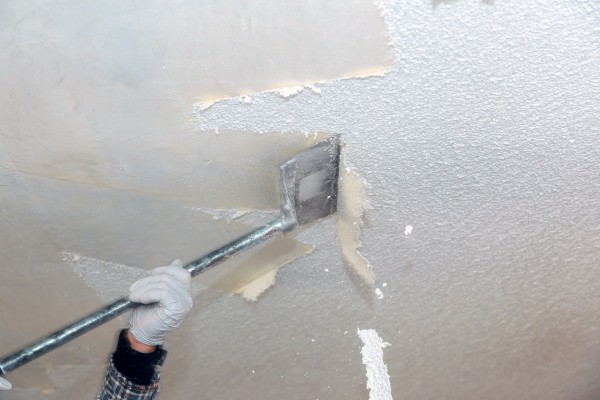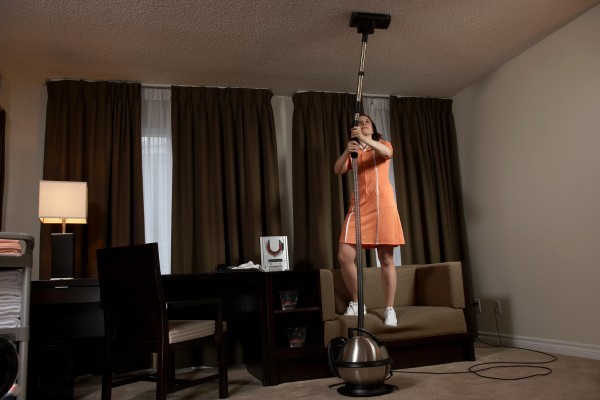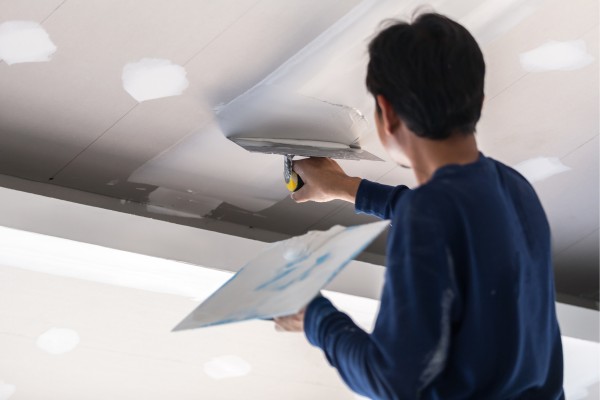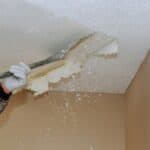They might look like harmless “cottage cheese” up top, but popcorn ceilings are dust magnets in disguise. These textured ceilings once ruled American homes from the ’50s through the ’80s—thanks to their sound-dampening perks and ability to hide imperfections. But cleaning them? That’s a different story.
Dust, cobwebs, and even grease stains can cling to those textured bumps like they’ve signed a lease. And one wrong swipe could crumble the popcorn texture or make an unsightly stain even worse.
So how do you clean a popcorn ceiling without turning it into a DIY disaster?
Stay with us as we explore safe tools, gentle techniques, and smart strategies for tackling stains without the mess.
Precautions Before Cleaning a Popcorn Ceiling

Before grabbing a sponge or vacuum cleaner, take a moment to prep smart. If your popcorn ceiling was added before 1980, there’s a real possibility it could contain asbestos—a material that’s now banned due to health risks. Don’t skip this step. Get it tested before you clean or even touch the textured surface.
Once you know it’s asbestos free, keep it simple: dry clean first. Wetting a dusty ceiling can turn loose dust into streaks or cause the popcorn texture to smear or fall off.
Cover your floors with drop cloths to catch falling debris, and if you can, move furniture out of the way. For anything that stays put, throw on some plastic sheets. And since you’ll be looking up, wear a dust mask and goggles—popcorn ceilings are known to drop more than just dust.
Always test your tools on a small patch before tackling the entire room. Better safe than scraping.
What You’ll Need to Clean a Popcorn Ceiling
Cleaning a popcorn ceiling isn’t complicated but it does require the right gear. Unlike flat surfaces, this textured ceiling style can crumble or smear if handled the wrong way. That’s why having the proper tools from the start makes the process smoother, safer, and way less frustrating.
To gently remove dust and tackle unsightly stains, you’ll need a few basics—nothing fancy, but every item plays a role. Think of it as assembling a toolkit that respects the delicate nature of popcorn texture while still giving you the power to handle deeper cleaning when needed.
Here’s what to keep nearby before you begin:
- Vacuum with a soft brush attachment – A must-have for lifting loose dust without flattening the textured surface. A vacuum cleaner works great for regular maintenance, especially on ceilings near ceiling fans or vents that collect dust quickly.
- Microfiber cloths – Ideal for gently dabbing small spots. Unlike paper towels or rags, microfiber won’t snag on the textured bumps.
- Dry cleaning sponge (chemical sponge) – These are your best bet for lifting smoke or soot without introducing moisture. If you have a kitchen ceiling with lingering residue, a dry sponge works like a charm.
- Spray bottle – Use a clean spray bottle to lightly mist the ceiling with a gentle cleaning solution. This helps treat mildew stains or light discoloration without oversaturating the surface.
- White vinegar – Mix equal parts white vinegar with warm water for a natural way to remove mold, grease stains, or odors.
- Step ladder – You’ll need a stable ladder to safely reach high corners. Make sure it gives you good visibility without requiring you to stretch.
- Protective gear: mask, gloves, and safety goggles – Whether it’s falling debris or floating dust, personal protection is important especially for ceilings that haven’t been cleaned in a while.
- Drop cloth or tarp – Falling debris is part of the deal. Lay down a drop cloth to protect your floors, rugs, or furniture.
- Flashlight (optional) – A flashlight can help spot stains or cobwebs in dim corners, especially in hallways or rooms without strong overhead lighting.
Quick tip: Avoid using abrasive sponges, rough cloths, or soaking the ceiling with too much pressure. Popcorn ceilings, especially older ones, are fragile.
Even a damp sponge used carelessly can cause the texture to crumble or smear across the surface.
Step-by-Step Guide: How to Clean a Popcorn Ceiling
1. Remove Loose Dust with a Soft Brush or Vacuum

Let’s start with the part that gives your ceiling that dull, dusty look—loose debris. Before you even think about using a spray bottle or cleaning solution, your first move should be clearing the dry stuff.
Think of it like brushing crumbs off a cake without smudging the frosting.
A vacuum cleaner with a soft-bristle brush attachment is your safest bet here. Attach the widest, gentlest brush head you’ve got—upholstery tools or low-suction settings are ideal. If you’re using something like a Shark Navigator or Miele with adjustable suction, go for the lightest setting.
Start in one corner of the room and work in small sections. Gently run the brush across the textured ceiling without applying too much pressure. You’re not scrubbing; just letting the brush collect dust that’s been clinging to those textured bumps for years.
If you don’t have a vacuum handy, a microfiber duster with an extension pole or even a feather duster will do. Just avoid anything stiff or scratchy—popcorn ceilings are fragile and can crumble with the slightest force.
Stick to light, upward strokes and take your time. You’ll be surprised at how much brighter the ceiling looks once all that loose dust is gone.
2. Spot Clean Stains with a Dry Sponge or Microfiber Cloth

Even the cleanest homes aren’t immune to the occasional ceiling stain. Maybe it’s cooking steam that drifted up from last night’s dinner, or a mystery yellow patch near the hallway light. Whatever the culprit—grease stains, mildew spots, or smoke residue—popcorn ceilings tend to hold onto them like bad habits.
To treat these stains without wrecking the textured surface, skip the scrubbing and go straight to a dry cleaning sponge, also known as a chemical sponge. These work well for lifting off smoke discoloration or light grime without needing water.
Just gently dab the stained area, never rub, or you risk smearing the stain or tearing the popcorn texture.
For softer marks or small spots, a microfiber cloth dampened with plain warm water can do the trick. Wring it out completely and test in an inconspicuous area first. Too much pressure or water is a recipe for peeling ceiling material.
If you’re dealing with water stains or mildew, mix a solution of one part bleach to three parts water in a clean spray bottle.
Lightly mist—don’t soak—the stained area once a day. Keep the room well-ventilated with a fan or open window so the textured ceiling dries completely. Letting moisture linger is one of the quickest ways to loosen popcorn texture or invite more mildew stains.
It’s a slow process, but with patience and the right tools, even the most stubborn stains can fade away without taking the ceiling with them.
3. Treat Mold or Smoke Residue

Stains are one thing but mold and smoke? That’s when your ceiling starts telling stories you didn’t ask for.
Whether it’s the faint gray haze from years of cigarette smoke or darker mildew stains from past leaks, these marks need more than just a quick wipe.
For light mold or mildew, a simple solution of one part white vinegar to three parts water in a clean spray bottle can go a long way. Lightly mist the affected area—think dew, not downpour—and then gently blot with a soft sponge.
No scrubbing, and absolutely no soaking. Popcorn ceilings don’t respond well to too much moisture.
When it comes to grease stains or smoke residue, mix 1 teaspoon of liquid dish soap with 1 quart of warm water. Spray just enough to dampen the spot, then dab gently with a soft sponge or cloth.
This works especially well in kitchen areas where steam and oil tend to creep upward over time.
Let the area dry completely, and don’t rush it. Use a fan or open the windows if needed—excess moisture is a one-way ticket to falling debris or fresh mildew.
And here’s a word of caution: if the ceiling has visible water damage or you suspect mold runs deeper than the surface, it’s best to call in a professional. Treating surface spots is fine but hidden mold inside the ceiling material can spread quietly and cause health issues if left unchecked.
4. Repaint or Refinish if Cleaning Isn’t Enough

Sometimes, no matter how gentle or persistent your cleaning process is, the stains just won’t budge. If your popcorn ceiling still looks dingy, or if the texture starts to crumble during cleaning, it might be time to shift gears from cleaning to refinishing.
Repainting is a practical way to cover stubborn stains and refresh the entire ceiling without removing the textured surface. Start with an oil-based, stain-blocking primer to seal in discoloration.
It’s especially helpful for water stains, smoke damage, or any area that keeps bleeding through even after repeated cleaning.
Once the primer dries, switch to a flat or matte acrylic ceiling paint for an even finish that hides imperfections. Be sure to test a small patch first, especially if you’ve never painted a popcorn ceiling before as it helps you avoid surprises.
Use a thick nap or specialty popcorn ceiling roller that’s designed to move across uneven surfaces without breaking down the texture. Because popcorn ceilings have more surface area than flat ones, you’ll go through more paint than usual—don’t be caught mid-roll with an empty tray.
One final note: never scrape or sand a popcorn ceiling unless you’re absolutely certain it’s asbestos free. When in doubt, call a pro.
Let Atlanta Maids Handle the Tough-to-Clean Spots
Popcorn ceilings are delicate, dusty, and often more trouble than they’re worth when it comes to cleaning. Even with the right tools and techniques, stains, odors, or signs of mold can hang around. And if the texture starts crumbling while you clean, that’s a clear sign to call in the pros.
Atlanta Maids knows how to handle the tricky stuff. From ceilings to baseboards, we use the right tools and gentle techniques to get your space fresh and spotless without damaging textured surfaces.
Whether you need a one-time deep clean or regular upkeep, we’re ready to do the dirty work so you don’t have to.
Ready to take cleaning off your to-do list?
Call (404) 905-5141 or schedule your service online with Atlanta Maids.
We’ll handle the grime while you sit back and relax.
FAQs About Popcorn Ceiling Cleaning
What is the best thing to clean popcorn ceilings with?
The safest way to clean a popcorn ceiling is by using a vacuum cleaner with a soft brush attachment, a microfiber duster, or a dry cleaning sponge. These tools help gently remove dust without damaging the delicate popcorn texture. Avoid using rough cloths, scrubbing sponges, or too much moisture, as they can loosen the textured surface or leave unsightly stains behind.
How do you get black dust off a popcorn ceiling?
Black dust is often a mix of soot, airborne pollutants, or even mildew stains. Use a vacuum cleaner with a brush attachment or a dry microfiber duster to gently remove dust without damaging the surface. Always wear a dust mask to avoid inhaling particles, especially in older homes or near ceiling fans that tend to collect dust and debris.
Is it safe to vacuum a popcorn ceiling?
Yes, as long as you use a vacuum cleaner with a brush attachment and low suction. This setup allows you to gently remove dust without pulling down the popcorn texture. Avoid direct suction or rotating brush heads, which can scrape or break apart the textured bumps on your ceiling.
What is the black stuff in a popcorn ceiling?
The black substance could be built-up dust, soot from candles or smoke, or even mold from excess moisture or past water damage. If the discoloration appeared after a roof leak or near a bathroom or kitchen ceiling, there’s a chance it’s mildew or mold. Treat cautiously and monitor for changes in the affected area.
How to clean black mold from a popcorn ceiling?
Start with a solution of one part white vinegar to three parts warm water in a clean spray bottle. Lightly mist the stained area and gently dab with a soft sponge—never rub or soak the surface. For stubborn stains or larger mold patches, professional mold remediation may be necessary to ensure safe and thorough cleanup.
Can you clean an asbestos popcorn ceiling?
No, you should never attempt to clean, scrape, or disturb a popcorn ceiling that may contain asbestos. If your ceiling was installed before 1980, have it professionally tested before cleaning. Cleaning asbestos-containing material without proper certification can release dangerous fibers into the air and poses a serious health risk. Always call a licensed abatement specialist for handling.

